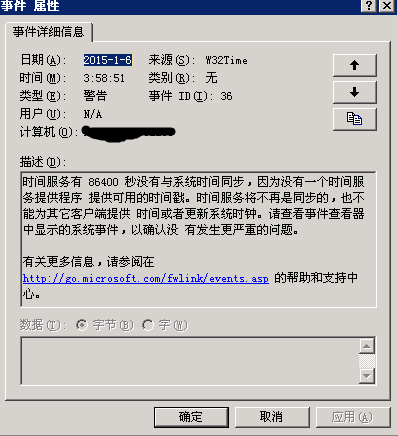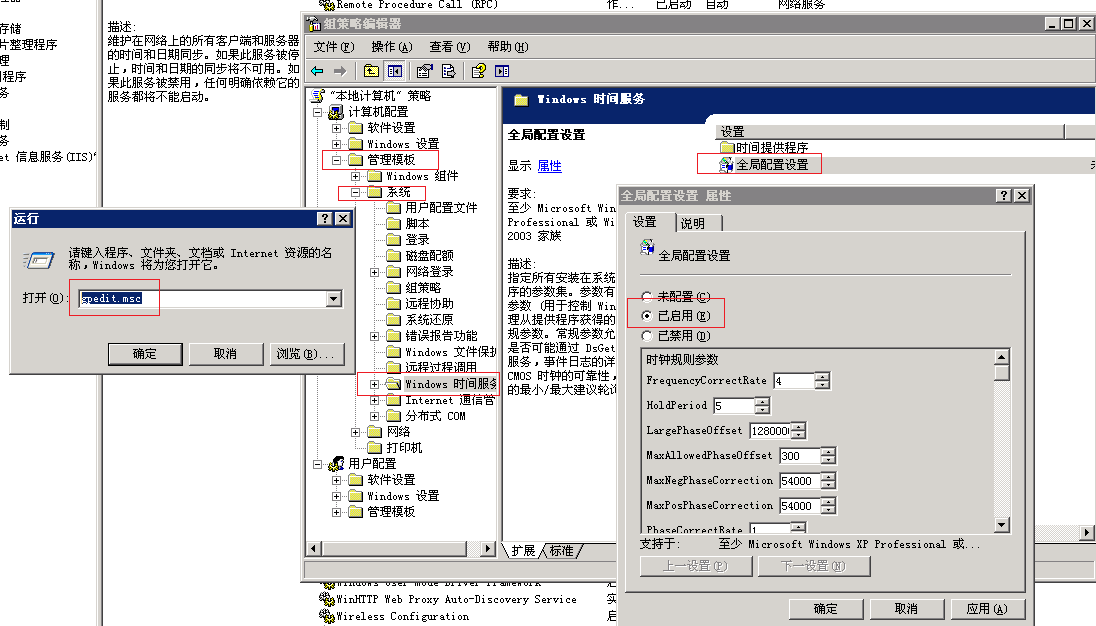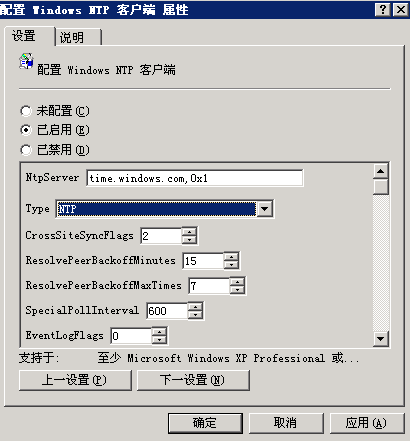Windows server2003时间同步
本文共 464 字,大约阅读时间需要 1 分钟。
之前写过一篇关于的文章,但是发现最近的Windows服务器时间也经常慢,最经常的设置见下图,但是实际使用过程中发现并没有同步成功。以下的步骤是为了去解决这个问题作出的尝试,总结和参考了很多网上的例子。
经过和同事的讨论,去查看一下服务器的系统日志,发现有如下问题
接着,查看以下参数
- RPC服务
- Windows time服务
如果以上已经打开,通过运行->gpedit.msc,进入到组策略模式,然后按照下图的步骤,先启用全局配置
然后配置NTP客户端,作用可以看系统介绍,见下图
接着我们配置NTP客户端参数,见下图
注意:几个重要参数介绍
- specialPollInterval:轮询间隔,单位为秒,我设置为10分钟,即600秒。
- type:NTP
其他几个参数暂时没有找到是做什么用处的,希望了解的人进行评论。
最后一步:重启Windows time服务和RPC服务。
你可能感兴趣的文章
Nginx配置Https证书
查看>>
Nginx配置ssl实现https
查看>>
Nginx配置TCP代理指南
查看>>
Nginx配置——不记录指定文件类型日志
查看>>
nginx配置一、二级域名、多域名对应(api接口、前端网站、后台管理网站)
查看>>
Nginx配置代理解决本地html进行ajax请求接口跨域问题
查看>>
nginx配置全解
查看>>
Nginx配置参数中文说明
查看>>
nginx配置域名和ip同时访问、开放多端口
查看>>
Nginx配置好ssl,但$_SERVER[‘HTTPS‘]取不到值
查看>>
Nginx配置如何一键生成
查看>>
Nginx配置实例-负载均衡实例:平均访问多台服务器
查看>>
Nginx配置文件nginx.conf中文详解(总结)
查看>>
Nginx配置负载均衡到后台网关集群
查看>>
ngrok | 内网穿透,支持 HTTPS、国内访问、静态域名
查看>>
NHibernate学习[1]
查看>>
NHibernate异常:No persister for的解决办法
查看>>
NIFI1.21.0_Mysql到Mysql增量CDC同步中_日期类型_以及null数据同步处理补充---大数据之Nifi工作笔记0057
查看>>
NIFI1.21.0_NIFI和hadoop蹦了_200G集群磁盘又满了_Jps看不到进程了_Unable to write in /tmp. Aborting----大数据之Nifi工作笔记0052
查看>>
NIFI1.21.0通过Postgresql11的CDC逻辑复制槽实现_指定表多表增量同步_增删改数据分发及删除数据实时同步_通过分页解决变更记录过大问题_02----大数据之Nifi工作笔记0054
查看>>




